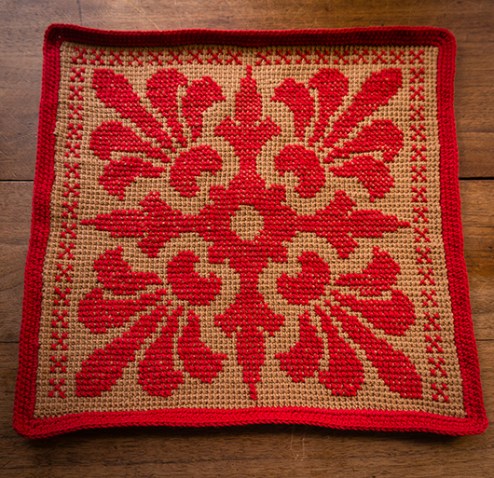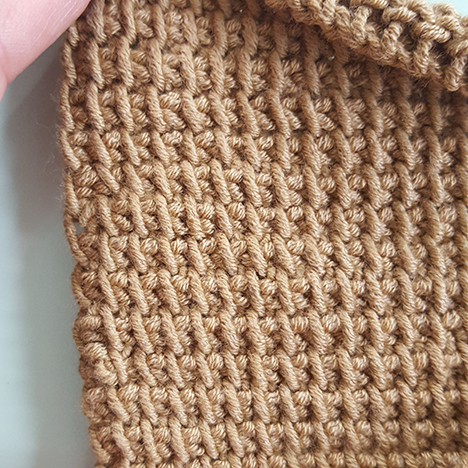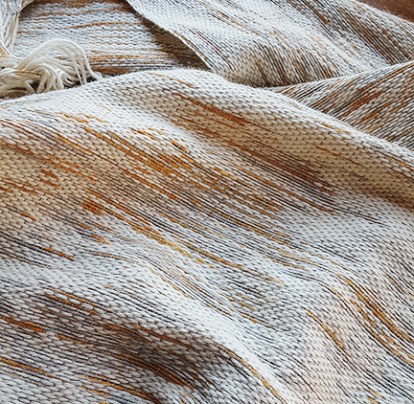 For an introduction to what does on in this column, click here.
For an introduction to what does on in this column, click here.
For the previous installment, and an introduction to the Five Hour Baby Jacket, click here.
Rosamund’s worries were unfounded. I finished the jacket for Upstairs Baby in due course, and he came down for a fitting.


Upstairs Baby didn’t say much of anything about the jacket; he was too interested in his fingers and Rosamund kept licking his toes. But his mother was enormously pleased. The fit is spot-on. Upstairs Baby is about two-and-a-half months old; exact finished measurements are in the pattern below.

Speaking of the pattern…
The biggest difference between the original and my version is the closure. The original (and all the subsequent variations I have found) have simple buttonholes made with yarn overs. Upstairs Baby’s has a single button-and-loop closure, because that’s what his parents said they would prefer.

The closure is extremely easy to make. The most difficult part is choosing the buttons. Skacel Buttons offers so many that Makers’ Mercantile is still in the process of adding them all to the online shop.
I used shank buttons; but whether you choose a shanks or flats, I highly recommend that you also use button backers on this or any other piece of knitwear. Backers add strength and stability. They can be purpose-made, or you can use (as I have here) plain, flat buttons out of your button stash. I’m guessing my grandmother cut these off an old shirt in the 1980s.

The stitch counts and gauge in this version differ from than those in the original. If followed exactly, the numbers in the original worked in a slender yarn at the recommended gauge of 4 stitches to the inch yield a very open, slack fabric. That’s not to my taste, and Chicago babies need warmth.
I want to be very clear that I do not consider the pattern that follows to be in any way an improvement on the original, which is a wonderfully clever and practical design. Aside from the changes noted above, all I’ve done is try to make the instructions very (very very) explicit, based in part on the questions that newbies left most often in the comments on other versions I’ve checked out. They may be annoyingly explicit for experienced knitters, who may find (for example) that the markers which set off the seed stitch borders are unnecessary.
If that’s so, that’s okay by me. Take the bits you like, set the rest aside. Do what suits you. That’s what patterns like this are for, after all.
(And by the way, though I’ve done my best to keep the errors at bay–well, you know how it is. Drop a note to Makers’ Mercantile if you find a goof, and we will correct it. Thank you!)
Franklin’s Five-Hour Baby Jacket: Yet Another Variation on the Theme

Yarn
The sample was knit with 6 balls Zitron Gesa & Flo **held double throughout**. Note that knitting with a single strand of Gesa & Flo will not give you a sweater of the desired size.
You may substitute any yarn that will give you the indicated gauge and a fabric that makes you happy. Worsted weight yarns are a good bet; you might also test sport weight and aran weight yarns to see if they will work–yarn weights are notoriously shifty.
I recommend both HiKoo Simpliworsted and HiKoo CoBaSi Plus. The latter is especially nice for those who live in climates where wool might be too hot.
If you do not take the time to knit a gauge swatch, your finished sweater will end up becoming a gauge swatch.
Needles and Notions
1 circular needle, length about 24 inches, size US 6 or size needed to give you proper gauge; always take time to check your gauge
1 16-inch circular needle or one set short straight needles of same size as the circular above
two small buttons (sample uses these, size 18mm in silver finish)
7 stitch markers
2 rigid stitch holders (recommended) or 2 lengths of contrasting scrap yarn
blunt tapestry needle
scissors (these, from Bohin, are my current favorites for keeping handy in my project bag and sewing box)
Gauge
5 sts and 7 rows = 1 inch in stockinette stitch
Finished Dimensions
Chest: 18 inches
Body Length: 9 inches
Yoke Depth: 3 inches
Arm Length: 7 inches
Arm Circumference: 6 inches
Notes
Seed Stitch. This very simple texture pattern is used in the collar, cuffs, and hem instead of the garter stitch found in the original version. Seed stitch is usually worked on an even number of sts as follows:
RS: (P1, k1) across.
WS: (K1, p1) across.
When worked across an odd number of sts (as in the collar), the texture is symmetrical, with a k1 at each end.
kfb (increase). Knit into the front of the st in the usual way, then into the back. Makes 1 new stitch.
m1 (increase). Cast on 1 new st by making a backward loop over the tip of the right needle (sometimes referred to as the loop cast on, thumb cast on, or “e” cast on).
Instructions
Yoke
Using the method of your choice, co 39 sts. (Model shown uses the knitted CO.)
Rows 1-4. Work in seed stitch (see “Notes,” above), ending each row with k1.
Row 5 (WS). K1, p1, k1; place marker; p to last 3 sts; place marker; k1, p1, k1. (Note that the first 3 and last 3 sts of all yoke and body rows–the stitches outside these two stitch markers–will be worked in this way, including WS rows. Assume that these markers will always be slipped when you encounter, them unless otherwise noted.)
Row 6. K1, p1, k1; *(kfb, k1), rep from * to last 4 sts; kfb, k1, p1, k1. (56 sts)
Row 7. K1, p1, k1; p to last 3 sts; k1, p1, k1.
Row 8. K1, p1; k to last 2 sts; p1, k1.
Row 9. K1, p1, k1; p to last 3 sts; k1, p1, k1.
Row 10. K1, p1, k1; *(kfb, k2), rep from * to last 4 sts; kfb, k1, p1, k1. (73 sts)
Row 11. K1, p1, k1; p to last 3 sts; k1, p1, k1.
Row 12. K1, p1; k to last 2 sts; p1, k1.
Row 13. K1, p1, k1; p to last 3 sts; k1, p1, k1.
Row 14. K1, p1, k2; *(kfb, k3), rep from * to last 5 sts; kfb, k2, p1, k1. (90 sts)
Row 15. K1, p1, k1; p to last 3 sts; k1, p1, k1.
Row 16. K1, p1; k to last 2 sts; p1, k1.
Row 17. K1, p1, k1; p to last 3 sts; k1, p1, k1.
Row 18. K1, p1, k2; *(kfb, k4), rep from * to last 6 sts; kfb, k3, p1, k1. (107 sts)
Row 19. K1, p1, k1; p to last 3 sts; k1, p1, k1.
Row 20. K1, p1; k to last 2 sts; p1, k1.
Row 21. K1, p1, k1; p to last 3 sts; k1, p1, k1.
Row 22. K1, p1, k3; *(kfb, k5), rep from * to last 5 sts; k3, p1, k1. (124 sts)
Row 23. K1, p1, k1; p to last 3 sts; k1, p1, k1.
Row 24. K1, p1; k to last 2 sts; p1, k1.
Row 25. K1, p1, k1; p to last 3 sts; k1, p1, k1.
Row 26. (On this row, you will place additional markers to indicate the fronts, back, and sleeves.)
K1, p1, k5, m1, k6, m1, k6, m1, k1, place marker. (23 sts for front)
K1, m1, k7, m1, k6, m1, k7, m1, k2, place marker. (27 sts for sleeve)
K2, m1, (k7, m1) 2x, k6, m1, (k7, m1) 2x, k2, place marker. (44 sts for back)
K2, m1, k7, m1, k6, m1, k7, m1, k1, place marker. (27 sts for sleeve)
K1, m1, k6, m1, k6, m1, k5, p1, k1. (23 sts for front)
Row 27. K1, p1, k1; p to last 3 sts; k1, p1, k1.
Row 28. K1, p1, k1. Knit across, inc by m1 before and after the 5 markers you placed in Row 26. DO NOT inc before or after the border markers you placed in Row 5. (152 sts)
Row 29. K1, p1, k1; p to last 3 sts; k1, p1, k1.
Row 30. Repeat Row 28. (160 sts)
Row 31. K1, p1, k1; p to last 3 sts; k1, p1, k1.
Sleeves
Work across right front as follows:
K1, p1, k1, slip marker, k22. Place these 25 sts (and the marker) on a stitch holder or length of scrap yarn. Remove the marker that indicates the beginning of the first sleeve.
**Begin sleeve (RS row):
(K1, kfb) 2x, k to 4 sts before next marker, (k1, kfb) 2x. Remove marker.
With second set of needles, work these 35 sleeve sts in stockinette st (k all RS rows, p all WS rows) for 26 more rows, ending by completing a WS row.
Decrease (RS) row:
K2; (k2tog, k3) 6x. (29 sts)
Purl 1 (WS) row.
Work in stockinette stitch (all RS rows, k; all WS rows, p) for 5 more rows.
Work in seed stitch (see “Notes,” above) for 4 rows, or for 8 rows if a turned-back cuff (shown on model) is desired. End each row with k1.
Break working yarn, leaving a tail of 10-12 inches.
With RS facing, join working yarn and k24 sts; m1; k across the remaining 24 sts before the next marker. Remove marker.
(IMPORTANT NOTE: the m1 in this row is designed to give the body an odd number of sts, and maintain the symmetrical seed stitch at the borders and hem. If you are adapting the pattern for yourself, and your border/collar/hem pattern does not require an odd number of sts, omit this increase and simply knit across the 48 sts of the back.)
The original pattern suggests that the back sts now be placed on a holder. I find I am able to leave them where they are on the circular needle cable, and knit the second sleeve with the same needle. Do whichever you prefer; what follows will be the same either way.
Return to ** and work the second sleeve exactly as the first.
Body
With both sleeves complete and with RS facing, join working yarn and work across remaining 25 sts (left front), ending with k1, p1, k1. This completes the first (RS) row of the body.
In the next row, you will join the live stitches on the needle to the back and right front sts that have been placed on holders. To do this, either knit them directly from the holder; or slip the empty left needle into the held sts from left to right, removing the holder once they have all been transferred. Take care not to twist sts as you transfer them.
Row 2 (WS). K1, p1, k1; p to last 3 sts; k1, p1, k1.
Row 3 (RS). K1, p1; k to last 2 sts; p1, k1.
Row 4. K1, p1, k1; p to last 3 sts; k1, p1, k1.
Rows 5-28. Repeat body rows 3 and 4. In Row 28, remove markers.
Work 8 rows in seed stitch (see “Notes,” above), ending each row with k1.
BO.
Seaming and Blocking
Sew underarm seams using tails from BO. Weave in ends. Soak and gently block.Allow to dry completely. Embellish if and as desired. (For information about the embroidery in the sample, click here .)
Loop-and-Button Closure
With circular needle (or a pair of double-pointed needles of the same size) CO 3 sts and work i-cord for a length of five inches. BO, leaving a 6-inch tail.
Using the CO and BO tails, sew the i-cord into a loop on the left-hand lapel of the jacket as shown, just below the final round of yoke increases.
Sew one button where the ends of the loop come together on the left front, and another in the corresponding place on the right front.
Tools and Materials Appearing in This Issue
Zitron Gesa & Flo Yarn (100% Ultra Fine Merino. 98 yards per 25 gram ball) shown in Color 08, Pastel Lavender.
Schoppel-Wolle Edition 6 Yarn (100% Merino extrafine Superwash wool; 328 yards per 50 gram ball) shown in Color 2296, English Garden)
Metal Dragonfly buttons by Skacel Buttons (shown in 18mm, silver finish)
About Franklin
Designer, teacher, author and illustrator Franklin Habit is the author of It Itches: A Stash of Knitting Cartoons (Interweave Press, 2008). His newest book, I Dream of Yarn: A Knit and Crochet Coloring Book was brought out by Soho Publishing in May 2016 and is in its second printing.
He travels constantly to teach knitters at shops and guilds across the country and internationally; and has been a popular member of the faculties of such festivals as Vogue Knitting Live!, STITCHES Events, the Maryland Sheep and Wool Festival, Squam Arts Workshops, the Taos Wool Festival, Sock Summit, and the Madrona Fiber Arts Winter Retreat.
Franklin’s varied experience in the fiber world includes contributions of writing and design to Vogue Knitting, Yarn Market News, Interweave Knits, Interweave Crochet, PieceWork, Twist Collective; and a regular columns and cartoons for Mason-Dixon Knitting, PLY Magazine, Lion Brand Yarns, and Skacel Collection/Makers’ Mercantile. Many of his independently published designs are available via Ravelry.com.
He is the longtime proprietor of The Panopticon, one of the most popular knitting blogs on the Internet (presently on hiatus).
Follow Franklin online via Twitter (@franklinhabit), Instagram (@franklin.habit), his Web site (franklinhabit.com) or his Facebook page.

































 Cee Cee Creech is growing up in a home full of creativity. Mom BeLinda loves making things, and Cee Cee loves it too. In 2011, Cee Cee changed their lives when she wanted to
Cee Cee Creech is growing up in a home full of creativity. Mom BeLinda loves making things, and Cee Cee loves it too. In 2011, Cee Cee changed their lives when she wanted to 














 I’m wildly excited to be making an in-person visit to Makers’ Mercantile on February 20, for a dinner to benefit the shop’s local animal rescue society and shelter,
I’m wildly excited to be making an in-person visit to Makers’ Mercantile on February 20, for a dinner to benefit the shop’s local animal rescue society and shelter, 









































































 Re-Enter the Bunny of Better Judgment
Re-Enter the Bunny of Better Judgment







